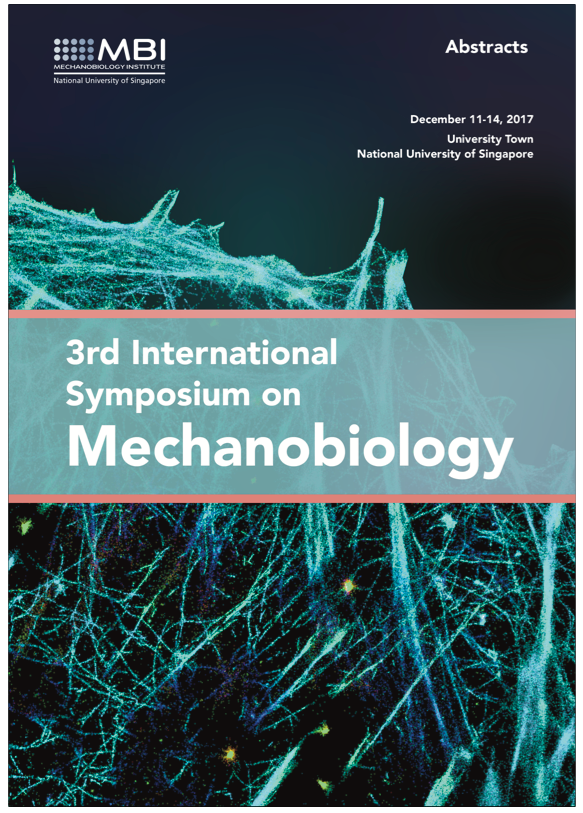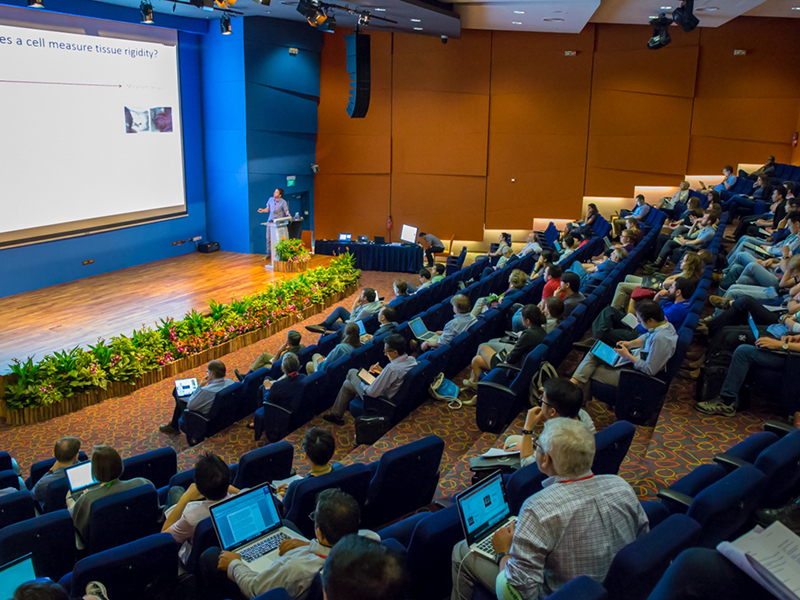2017 ISMB III – 3rd International Symposium on Mechanobiology: Post-event report
SRUTHI JAGANNATHAN | JANUARY 2018
The 3rd International Symposium on Mechanobiology (ISMBIII), jointly organized by the Mechanobiology Institute and the International Society of Mechanobiology, was held between 11-14 December at University Town, National University of Singapore. The symposium was aimed at bringing together scientists working in the field of Mechanobiology and related sciences to discuss their innovations and discoveries and advance knowledge in basic and applied research in this rapidly emerging field.

Participants of the 3rd International Symposium on Mechanobiology held 11-14 December, 2017, in Singapore.
The scientific presentations on Day 1 of the symposium followed these major themes: actin cytoskeleton, mechanopathology, theory and simulations, development, cell-cell interactions, forces & energy in biosystems, and mechanobiology of nuclear and chromatin deformations. The sessions were opened by keynote lectures, followed by a line-up of interesting talks under each of these topics. Other major highlights of the day were the two plenary lectures, one by Prof Benjamin Geiger from the Weizmann Institute of Science, Israel on the mechanisms regulating the invasive migration of cancer cells and another by Prof Michael Sheetz, Director of the Mechanobiology Institute who described the multiple mechanosensing and mechanotransduction steps in anoikis and cancer.

Nisha Mohd Rafiq from MBI’s Alexander Bershadsky’s lab presents her findings for ISMB participants.
On Day 2, the major themes for talks and discussion were mechanotransduction, patterning, mechanobiology in diseases, geometry and rigidity sensing, single-molecule force spectroscopy, mechanosensing, and immunomechanobiology, microscopy & spectroscopy, polarity, and cancer mechanobiology. The participants attended two plenary lectures: Prof Thomas Lecuit from Aix-Marseille Universite and CNRS, France talked about the regulation of cell mechanics during tissue morphogenesis, while Prof Birgit Lane from the Institute of Medical Biology & Skin Research Institute of Singapore, described the biomechanical functions of keratin filaments. Apart from these, the sessions began with keynote lectures and were followed by several other talks.
Day 3 of the symposium commenced with a plenary lecture by Prof Anna Akhmanova from Utrecht University, Netherlands on the molecular mechanisms involved in microtubule-based control of cell motility. This was followed by keynote lectures and other talks on topics ranging from tissue to molecular mechanisms of cell mechanosensing and sarcomere-like organization and dynamics in fibroblasts and cardiomyocytes. The sessions post lunch began with another plenary lecture by Prof Satyajit Mayor from the National Centre for Biological Sciences, India who described the role of integrin signaling in generating acto-myosin driven functional nanoclusters of GPI-APs. More keynote lectures and talks continued through the afternoon.

Plenary lecture by Prof Satyajit Mayor from the National Centre for Biological Sciences, India
Following three days of intense presentations and discussions, it was time to sit back and relax during the conference banquet that was held on the evening of Day 3 at a picturesque venue at Gardens by the Bay, Singapore. The lively evening also provided the symposium participants with a more informal setting for networking and fostering collaborations.
Scientific presentations followed the major themes of: actin cytoskeleton, mechanopathology, theory and simulations, development, cell-cell interactions, forces & energy in biosystems, and mechanobiology of nuclear and chromatin deformations.
The fourth and final day of the symposium got going with two plenary lectures, one by Prof Beth Pruitt from Stanford University, USA and another by Prof Masatoshi Takeichi from the RIKEN Centre for Development Biology. Prof Pruitt spoke about engineering microsystems for quantitative mechanobiology, while Prof Takeichi elaborated how adherens junction components stabilize the polarity of migrating cells via Myosin-II regulation. The morning proceeded with insightful keynote lectures and talks on vinculin, membranes, and mechanosensitive ion channels. The presentations on Day 4 concluded with a special lecture by Prof Boris Martinac from Victor Chang cardiac Research Institute, Australia on the ‘Force-from-lipids’ principle of mechanosensing at the membrane interface.
Apart from the talks, several poster sessions were also held, during which student and post-doc participants presented their latest research under the major themes covered during the symposium. Of these, top 3 presentations were selected under both student and post-doc categories and awarded during the closing ceremony at the end of Day 4 that wrapped up this 4-day intellectual feast.







